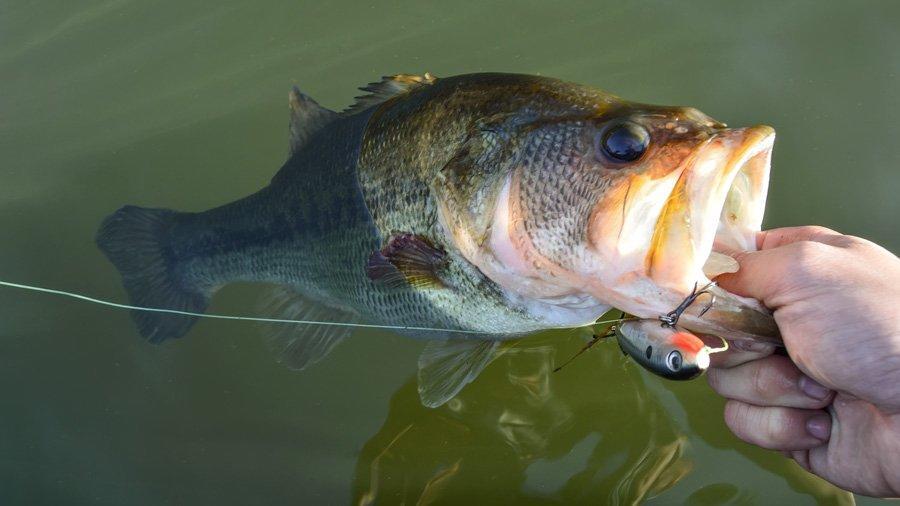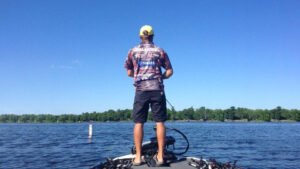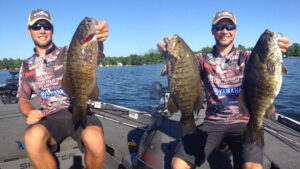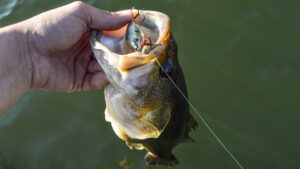It seems like every year, around the post spawn, you start to hear dock talk of guys winning tournaments on a topwater lures. Either at the weigh-in scale or later through the morse-code-like dialogue bass anglers tend to engage in, someone is inevitably going to be giving a hushed description of giant bass busting their surface baits. More often than not, this lure turns out being a “walk-the-dog” type topwater bait.
Whether it has to do with water temperature, the moon phase, or because big female bass are already mad at the world after a long spring; it seems when the post-spawn rolls around, bass fall hard for walking topwaters.
Brandon Palaniuk shared his thoughts on the topic of walking topwater baits. Palaniuk was able to shed light as to why walking baits are so effective and how he utilizes them during the post-spawn period.
WHEN TO START THROWING WALKING TOPWATERS
Once someone wins a tournament or two on a walking topwater, the rest of us follow suit and will have one tied on to our favorite rod from that point on, all the way into autumn. Besides hearing of other anglers starting to catch bass on these lures, there is an easier way to know “the right time” to throw one. Palaniuk’s answer might surprise you.
“Once I start to see the water temperatures stabilizing in the upper 60s to 70 degrees, which is usually around the post spawn, they’ll eat a walk-the-dog topwater,” Palaniuk said. “But it all depends on the situation.
“The Bassmaster Classic on Lake Hartwell this year is a perfect example. It was 10 degrees outside when we launched with water temperatures in the 40s and there were still bass busting blueback herring on the surface.”
Anytime bass are actively feeding on baitfish at the top of the water column, Palaniuk won’t hesitate to pick up a walking topwater bait.
WHERE TO FISH
Because of the versatility and drawing power, Palaniuk will fish these baits in a variety of locations. His two favorite areas to focus on with walking baits around the post spawn are large flats and individual targets.
Focus on Flats – Just like during the prespawn phase, bass in the post spawn are often on the move. Many will be leaving the major spawning flats and heading out towards deeper water to rest and get their bellies full after a long spawning season. Brandon uses a walking bait to intersect these fish.
He’ll try to find small ditches or channels leading to and from these expansive flats. If he finds something like this, Palaniuk has found a perfect area to put his walking topwater to use. The spawned-out bass will be using the ditches like a highway and will be more concentrated. Due to the commotion a walking bait makes, they have incredible drawing power on flats and will pull fish great distances.
Palaniuk opts for a steady retrieve and cadence for his walking baits when fishing these big homogenous flats. He has found these bass are more likely to be fooled by speeding his retrieve up rather than slowing it down. Whether Brandon is targeting smallmouth on a sand flat or largemouth on a submerged grass flat, he’ll still use the same approach.
Target Practice
Palaniuk loves fishing broad flats with walk-the-dog type topwaters but won’t hesitate to fish them in and around specific targets. The two types of targets Palaniuk specifically mentioned were isolated cover and bluegill or bream beds.
Isolated Cover – Especially when fish are in the post-spawn mood, Palaniuk won’t pass by a piece of isolated cover without throwing a bait at it. He has found he can often pick off big bass from these lone pieces of structure with a walking topwater. He’ll focus on big out-of place boulders, isolated lay-downs, individual docks, or even a lonesome grass patch.
As the bass spread out throughout the post-spawn these isolated targets become high percentage areas to focus your efforts on.
Panfish Spawning Beds – Another tried and true focal point for big bass with walking topwaters are bluegill and bream beds. Palaniuk has found bass are usually finishing up their spawning behavior around the same time the panfish are starting theirs. All those spawned-out female bass don’t rush away from the bank all at once.
In fact, Palaniuk has noticed that big bass will take the easy lunch, so to speak. They’ll lay in wait right on the edge of these panfish spawning beds and that is exactly where Palaniuk will target them with his walking top-water.
“A walking bait is so effective around bream beds because you have the ability to vary your retrieve.” Palaniuk explained. “Bass on these panfish beds are usually pretty finicky, but by experimenting with your cadence, you figure out what they want.
“I like to work the bait up to the bream beds quickly and then kill it right on the edge of their spawning beds. If that doesn’t work, I’ll give the bait one or two twitches. If they are there, a bass will usually come crush it.”
WHAT IS THE BIG IDEA
As many savvy bass anglers will tell you, topwater baits in general, seem to attract bigger than average size bass, especially in the spring. This can be hugely important if you are a tournament fisherman looking for five big bites, or if you are out fun fishing and want to catch bass-squatch!
I’ve read all sorts of literature on this phenomenon, but Palaniuk’s explanation made as much sense as anything I’ve heard.
“Sure, bass are ambush predators, but they are also extremely opportunistic predators,” Palaniuk said. “When a bass sees a baitfish skittering and struggling across the surface, it knows it has that prey trapped.
“The prey has no piece of cover to hide in and literally have nowhere to go but up, if they want to get away. A bass is almost genetically programmed to take that opportunity, which is why a walking top-water will bring in a big bass from a long way.”
PALANIUK’S TACKLE SUGGESTIONS
In this day and age, there are about 2 million different rod, reel, and bait combinations out there to help sufficiently confuse anglers choosing gear. When it comes to walking topwater baits, Palaniuk keeps his choices simple.
Lures
Even with a myriad of different bait choices, Palaniuk will usually keep his walk-the-dog topwater choices to two baits.
- Rapala X-Rap Walk – Palaniuk likes to stick with the number 9 size and grabs this lure when he is making long casts and targeting expansive flats. Palaniuk commends the X-Rap Walk for casting a mile and having a really loud, attractive sound. Perfect for drawing in fish scattered across a flat.
- Rapala Skitter Walk – The Skitter Walk is Palaniuk’s go-to walking topwater when fishing individual targets like docks, lay-downs, or bream beds. This bait has a tighter side-to-side cadence, facilitating its use in close quarter situations.
“Sometimes I’ll throw Rapala’s saltwater version of the Skitter Walk,” Palaniuk divulged. “It measures about an inch and a half longer than the regular Skitter Walk and still has all the same great features, just with a bigger profile. ”
Brandon makes sure to switch out his hooks on the Saltwater version of the Skitter Walk to No. 3 or No. 4 VMC Trebles to ensure he hooks every fish that smacks at his bait.
When it comes to colors, Palaniuk notes that water color will often have a lot to do with his choices. Generally speaking, Palaniuk with reach for lighter, more translucent colors with clear water or sunny conditions and stick with darker, more opaque colors if it’s cloudy out. He notes there is no one correct answer to this question. You have to experiment with different color combinations to see what the fish want.
Rod
Sticking with the K.I.S.S. approach (Keep It Simple Stupid), Palaniuk throws his topwaters on an Abu Garcia 7-foot medium-action micro guide Veritas rod.
“That rod is amazing. It retails for only $100 and is about as good as it gets for a topwater rod,” Palaniuk said. “It has the backbone to make the long casts I want, while it still has plenty of give in the tip so you don’t rip the bait out of the fish’s mouth.”
Reel
Palaniuk throws his Rapala walking baits on an Abu Garcia Revo MGXtreme in 7:1:1. He favors a fast gear ratio to have more control over the cadence of the lure and to be sure he can catch up with an explosive bass once his bait gets swallowed.
Line
The type of line to throw your topwater on is one of the most important parts of the entire system. While many anglers are die-hard one way or another, Palaniuk finds himself switching up between braided line and monofilament, depending on the situation.
Braid – If Palaniuk is fishing flats, you can bet he’ll be chucking his topwaters on 30 to 40-pound Berkley Trilene Professional Grade Braid. The braided line helps him make long casts while improving his hook-up ratio at the end of long casts. When you have 30-40 yards of line between you are your lure, the no-stretch of braid helps make sure the hooks find their home in the fish’s mouth.
Mono – Similarly to wanting no-stretch on long casts, Palaniuk wants some stretch when fishing close quarters and casting to individual targets. He finds that in 12 to 15-pound Berkley Trilene XL monofilament.
“Everyone knows you’re supposed to give ‘em a second when they eat a topwater bait, but it’s easy to say and so hard to do,” Palaniuk said. “When a giant bass comes from under a dock and explodes on your topwater 20 feet away, it’s hard not to freak out and pull the bait away from them. It’s exciting! That’s why l’ll stick with mono when I’m fishing close-quarters, it gives me and the bass a split-second longer for the bait to hook up.”
With rising temperatures in the spring, topwaters earn primetime placement for catching big bass. Instead of kicking yourself for missing the boat on an early topwater bite this year, tie on a walking topwater bait and follow some of Palaniuk’s tips.
If you do, there likely will be some big topwater explosions, big bass and big grins in your near future.















